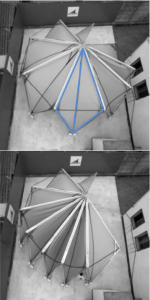Nowadays, there is a growing demand for flexible and dynamic architecture. More and more applications ask for adaptable structures, which are adjustable in a way that they can meet the current needs. Therefore, kinematic lightweight structures offer an excellent solution. These reconfigurable frames with a technical textile cover can offer a great variety of configurations.
The major task in analyzing the structural behavior of Kinematic Form Active Structures (KFAS) is to investigate the stiffness and stability during all phases of deployment. The design and optimization process contains a study of their geometric compatibility, pre-tension and curvature.
The study of the structural response of the membranes in KFAS, forms the main task of the FWO-project “Integrated analysis and experimental verification of Kinematic Form Active Structures (KFAS) for architectural applications”. The project consists of an experimental part, where the feasibility is checked thoroughly, and a numerical part, where an optimization of the numerical models is performed.
Several software packages for the numerical analysis of membrane structures have been developed during the past decades, still incorporating a number of simplifications related to the material characteristics, such as anisotropy, non-linear behavior, crimp interchange, shear and relaxation phenomenon. This hinders a correct analysis and hence results remain insufficiently accurate for the studied KFAS. The experimental results are here used to validate and optimize the numerical simulation.


